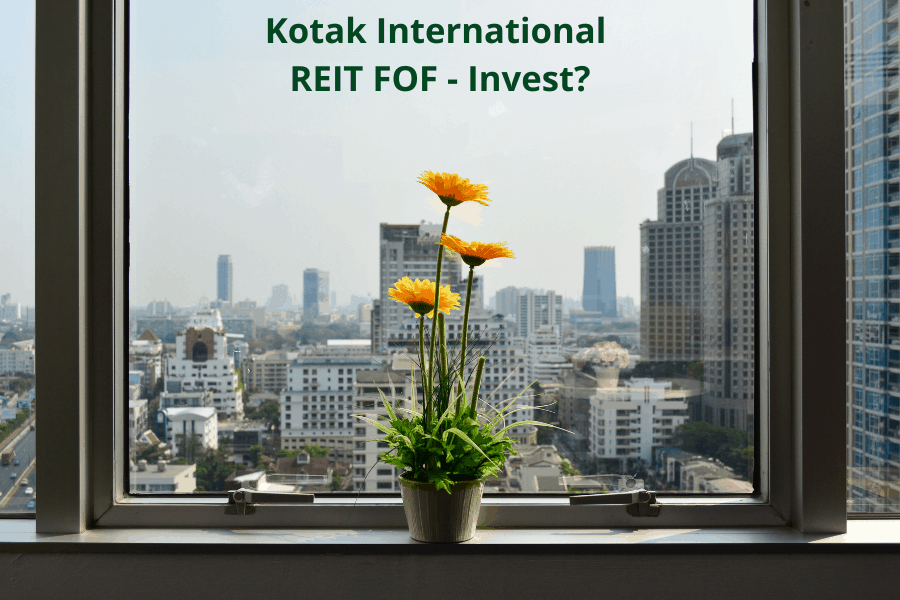If you are looking at financial instruments to invest in real estate, there are only 2 options now in the listed REIT space (though there are more lined up). REITs in India are at an early stage of their product lifecycle and may well hold promise. But instead of waiting for it, Kotak AMC has decided to provide you an opportunity to shop in the more vibrant Asia-Pacific REIT market, with its Kotak International REIT Fund of Fund (FOF).

What is an REIT?
For those uninitiated to real estate investment trusts (REIT) – these are companies that own, operate or finance properties across sectors (commercial, retail, logistics, data centers and so on). The underlying properties either provide income- generating opportunity through rentals or capital appreciation opportunity to the REITs. The income so generated by the REIT is typically distributed to the extent of 90% to unit holders. REITs can be listed in the stock exchanges as units that can be held by investors both retail and institutional.
When a scheme holds a basket of listed REITs, it becomes a REIT mutual fund. Kotak AMC plans to invest in one such international REIT fund that holds a basket of Asia-Pacific-based REITs.
About Kotak International REIT FOF
Kotak International REIT FOF (Kotak REIT FOF) is a mutual fund and not a REIT. It is a Fund of fund that will invest in units of SMAM Asia REIT Sub Trust Fund. This underlying fund, domiciled in the Cayman Islands, is managed by Sumitomo Mitsui DS Asset Management Company Limited (SMDAM), a Japanese-based firm that operates $120 billion of global assets. The REIT is stated to be the largest Asia Pacific (ex-Japan) REIT fund.
The underlying REIT fund will invest in a basket of listed REITs across countries that include Singapore, Hong Kong, and Australia. These REITs are not just invested in commercial or residential properties only. They span across real estate in sectors such as data centers, warehousing and logistics as well.
An important point you need to note on ‘distribution of income’ if you are used to a REIT structure is this:
- Kotak REIT FOF will be like any other mutual fund – what the fund does is to invest in another fund that in turn invests in REITs. It is not a REIT. Therefore, the rules of distribution of income will not apply here.
- The income that the underlying REITs distribute will be added to Kotak REIT FOF’s NAV. So the fund will get the benefit of income distribution in its NAV.
- Kotak REIT FOF will have dividend and growth options just as all mutual funds do. The fund is not under any obligation to pay dividends. Any dividend the fund pays out will be at its discretion and will not be related to the income distribution of the underlying REIT.
As an international fund, Kotak REIT FOF’s capital gains taxation will be like a debt fund. Holding over 3 years will entail indexation benefit while gains less than 3 years will be taxed at your slab rate.
Advantages
For those wanting to test waters in real estate, the global segment offers some clear advantages over local REITs.
#1 Diversification across property segments
The Indian REIT market as it stands today does not really echo its more developed market peers in Singapore, Hong Kong, or Australia. For example, while the REITs here are largely in the commercial space, the basket of REITs in SMAM Asia REIT fund will cover other segments such as logistics, warehousing and data centers apart from the traditional property holdings. This is particularly of help in situations such as the present one – where COVID-19 19 has driven many working-segments to opt for work from home.
The advantage with a structure that invests in a basket of REITs is that it can go underweight or overweight certain property segments based on market conditions. For example, the SMAM Asia REIT Fund is currently underweight retail and commercial compared with its benchmark and instead has higher exposure to industrial segment. This gives an edge in terms of managing downsides in certain segments better than owning individual REITs.
#2 Geographic diversification
While one can argue that some of the large REIT markets of US or Canada are absent in this portfolio, the Asia Pacific market provides an ideal combination of a well-structured REIT market but one that is still growing.
Geographies such as Singapore or Hong Kong for instance are touted to have among the most expensive properties in the world. According to data available with SMDAM, the average dividend yield of REITs as of October 2020 was 4.7% in Singapore, 5.3% in Hong Kong, 2.8% in UK and 4.4% in US. The spread between this and the respective countries’ 10-year govt. bond yields are also higher in the Asian markets.
#3 More organized realty market
The real estate market in the Asia Pacific region is far more organized than the Indian market. While the Indian REIT space is largely dependent on decent yields in commercial segments, the more promising residential segments suffers from many limitations. For example, Singapore has a clear rental policy for the residential segment that makes it conducive to float REIT structures. Similarly, property prices are region-driven in India but less so in Asian markets. Lack of transparency and disclosure in the real estate space in India has also meant poor management of supply-demand dynamics. As a result, the residential space suffers from poor yields of 1.5-3 percent.
#4 Simple tax structure under the mutual fund route
REITs in India have a 3-layered tax structure. Any interest income or rental income from the REIT is treated like other income and taxed at applicable rates. Dividend income (post the 2020 budget) is tax free in your hands if the REIT did not go for any concessional tax slab. If it did, then you would have to pay taxes at applicable rates (slab rate).
With the Kotak International REIT FOF, the structure is simple and like any international fund (which is the same as debt fund taxation). You have gains on your NAV. If you sell the fund in less than 3 years, the gains are taxed at your slab rate. For holdings over 3 years, you are taxed at 20% after indexation (for resident individuals).
Performance and currency matters
The underlying fund’s performance since its inception in 2011 is given below. Please note that it assumes dividends to be reinvested and is not the returns of just the unit price. The below data is in rupees.
It is noteworthy that the SMAM Asia REIT Fund (into which Kotak invests) is domiciled in the Cayman Islands (likely for beneficial tax structure) and has a Japanese yen-denominated share class. That means that the Kotak fund will invest in this share class. While Kotak has stated that it is in discussions for a USD share class, unlike your other international funds that are predominantly dollar-invested, this is in Japanese yen.
The rupee has depreciated about 5.6% annually against the yen in the past decade. That means the rupee returns you see in the above graph would be higher than the yen-denominated returns. But here again, there is one more level of currency exposure. Since this is a basket of REITs, the investments are made in local currencies in Singapore, Hong Kong, Australia, and the likes. Hence, you cannot be sure which currency gave you the edge or pulled your returns down as the case may be.
Should you invest?
So, here’s how we would take your questions on this.
- Is this the best global REIT to take exposure to? We really don’t know. We do not have the data nor the understanding of global REIT markets to declare this. In the near future too, we won’t be too well placed to take a call on the prospects of this fund. But what we do know is that Asia Pacific has a vibrant real estate market.
- Can this be a good diversification? We do think it can be. For one, you do not need to take exposure to a single REIT, it is a basket. Two, you are diversifying into a more mature and well-structured market than India. You do not have to wait until such transition happens in India.
- Is this better than buying one of the two REITs in India? We cannot be sure about the performance of this fund over Indian REITs. But what we can be sure of is that you will be diversifying your risks across several REITs in more structured markets. To this extent, your risk-adjusted return could well be good.
- Should you buy only during the NFO? Not necessarily. You could buy anytime. But as you will see from the current calendar year’s performance, the underlying fund has just about managed to keep itself afloat. The pain caused by COVID-19 -19 has no doubt impacted REITs. That can be a reason to invest some amount now. So, if you decide to buy them, you could consider investing now followed up by small sums through SIPs. Please be prepared for any prolonged pain because of the current environment and take a long-term view (5 plus years)
- How much exposure to take? we would think not more than 5% of your total portfolio should be in this for now. The concept is new to India (basket of REITs) and there is no real control by the fund manager here (fund of fund). We are also not too comfortable with the country where the fund is established (Cayman Islands) although Sumitomo Mitsui is a large group. So, it is necessary to test waters with care.
- Can you invest even if you have exposure to physical real estate or to REITs? Yes, we think you can since the nature of exposure that this fund would give you would be significantly different from what you are likely to hold.
The NFO closes on December 21, 2020. While the actual expense ratio will be known only post NFO, it is capped at 2% according to the scheme information document. That means the Kotak FOF cannot charge more than 2%. Note that the underlying fund has an expense ratio of 1.73% (as of October 2020. Source: SMDAM) lus local taxes. This is already deducted in the underlying’s fund’s NAV and not charged on you separately.
Related: About HDFC Housing opportunities fund – should you exit?







30 thoughts on “Prime Review: Kotak International REIT FOF NFO – Should you invest?”
Where can I find about the expense ratio and exit load
Expense ratio – In fact sheet a month after the fund reopens post NFO. Exit load is 1% within 365 days.
Thanks for the informative analysis. Given that the underlying REIT has 1.73% and the FOF can charge 2%, does it mean that the total expenses would be approximately between 3.75% and 4% ?
Expense ratio is not 2% SEBI allows up to 2% It will be much lower. 1.73% is on the parent fund and so yes, indirectly you get to bear it. thanks, Vidya
Is it better to buy growth or dividend, dividend is non taxed in REIT?
Growh please. dividend is indeed taxed for a fund. this is a fund not a REIT. Vidya
Hi,
My question would sound very stupid but have to ask as no one has any clue not even my Relationship Manager at Kotak or Axis. How do I invest in this fund? Though the NFO has opened but cannot see the fund listed on portal. I also invest through Kuvera but cannot see it on their portal too. Am I missing something here. Would request some guidance and light on this matter.
Many thanks in advance
Regards
Gaurav Malik
It was launched only on 7th. You should get it in few days. Else, you can try their website – https://online.assetmanagement.kotak.com/ thanks, Vidya
Thanks Madam
Kotak NFO well explained.
Sudhakarudu
Nice Insights Vidya!
This is like breathing fresh air amidst the himalayan ranges travelling through the MF schemes, just keen to know their break up % distribution especially across property segments(Data Centers, Warehousing, Logistics) for the past 5 years and has that increased during Covid time and also these securities are rated by any credit agencies like Nomura will give some idea on their credentials.
If we get the data we will share. Can’t expect much info from a ‘Cayman Island’ listed entity 🙂 Vidya
Thanks Vidya, great insight. When is Kotak launching this, haven’t seen any mail from them(promotional). Last promotional mail was on ESG fund.
Launched today. thanks, Vidya
Nice to have a solid info on this REIT NFO, hope you will also write such a knowldgable one on Invesco Global Consumer Trends FoF NFO.
Thanks.
Hello Vidya and team,
Thank you for coming up with such insightful peices regularly. Could you also provide some guidance around how does real estate as an asset class corelate with equity from your past experiences? Can we use this fund as a diversification tool in addition to something like gold in our portfolio or should we be just treating it as debt while we tinker with our asset allocation?
Best regards
Prashant
Hello Sir, thanks. Yes, you could use it as an asset allocation but in small quantities now as mentioned in the article. Real estate and equity – we would love to do if there is one universal data for the country. There is NHB residex but it comes with a significant lag for any meaningful correlation. The data given region-wise by real estate consultants is far from ground reality. thanks, Vidya
Comments are closed.